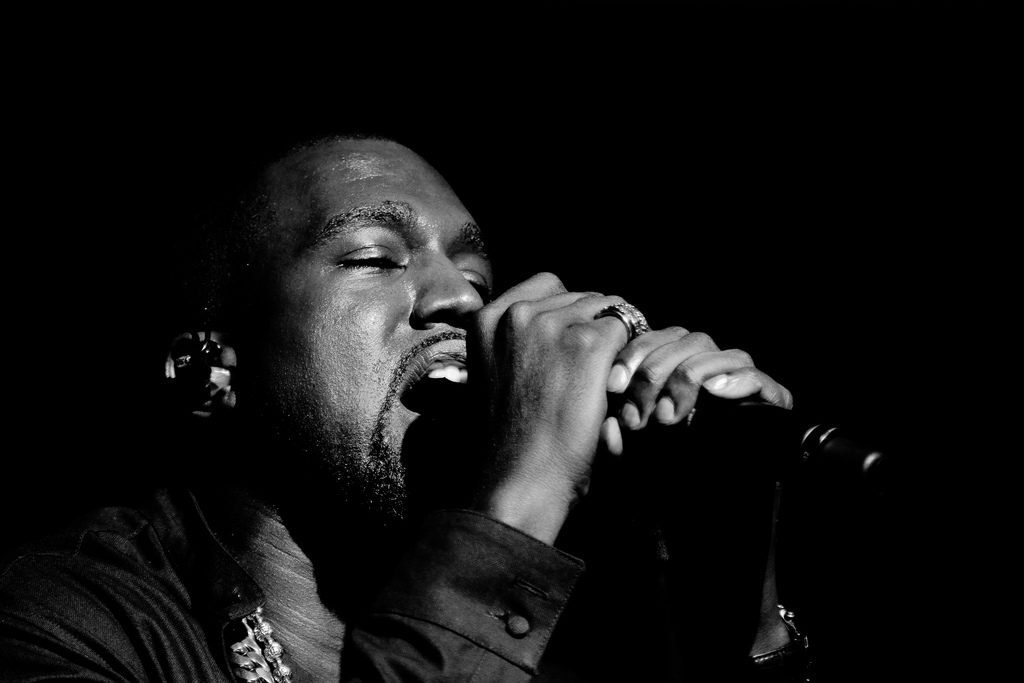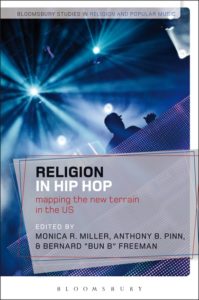
L. Benjamin Rolsky
In part one, Rolsky focused on hip-hop artist Kendrick Lamar to begin his discussion on the study of religion in hip-hop as it is construed in general and how it appears in particular in the work of scholars of the study of religion and hip-hop: Anthony B. Pinn, Monica R. Miller, and Bernard “Bun B” Freeman. In part two Rolsky takes a look at Pinn, Miller and Freeman’s book to explore the methodology of studying religion in hip hop and dives into some critiques of the form.
Parts of this two-part series originally appeared in a longer version for HNet Reviews AmRel in 2015. For more information, please click here.
How to Study Religion in Hip Hop
 For Anthony B. Pinn and Monica R. Miller, Religion in Hip-Hop: Mapping the New Terrain in the US attempts to “advance a methodological and theoretical housing for the study of hip-hop and religion” in a key of “critical” approaches to the study of religion. On top of this, the inclusion of an “insider perspective,” namely Bernard “Bun B” Freeman’s, demonstrates that artists possess the ability to “return the gaze” of the academic, thus “rapping back” about religion in hip-hop. In essence, the edited collection seeks to accomplish three interrelated goals: highlight the critical issues in the field, bring artists and scholars together, and provide scholars with a “critical roadmap” based on the most significant topics and questions in the field. Many of the theoretical and methodological insights in the book benefit the field writ large because they introduce new data to the study of religion and hip-hop and push scholars to re-examine how best to study human life as an amalgamation of innumerable social processes and identity formations. To end the analysis at this juncture, however, may be a necessary step for the advancement of scholarship, but it is ultimately not a sufficient one. I passionately salute the editors’ work in theory, but in practice their suggestions arguably reify categories over characters, function over content, purpose instead of thick (or thin) description. Despite these criticisms, the text is a crucial development in the study of religion and hip-hop and will ground future studies of the subject for years to come.
For Anthony B. Pinn and Monica R. Miller, Religion in Hip-Hop: Mapping the New Terrain in the US attempts to “advance a methodological and theoretical housing for the study of hip-hop and religion” in a key of “critical” approaches to the study of religion. On top of this, the inclusion of an “insider perspective,” namely Bernard “Bun B” Freeman’s, demonstrates that artists possess the ability to “return the gaze” of the academic, thus “rapping back” about religion in hip-hop. In essence, the edited collection seeks to accomplish three interrelated goals: highlight the critical issues in the field, bring artists and scholars together, and provide scholars with a “critical roadmap” based on the most significant topics and questions in the field. Many of the theoretical and methodological insights in the book benefit the field writ large because they introduce new data to the study of religion and hip-hop and push scholars to re-examine how best to study human life as an amalgamation of innumerable social processes and identity formations. To end the analysis at this juncture, however, may be a necessary step for the advancement of scholarship, but it is ultimately not a sufficient one. I passionately salute the editors’ work in theory, but in practice their suggestions arguably reify categories over characters, function over content, purpose instead of thick (or thin) description. Despite these criticisms, the text is a crucial development in the study of religion and hip-hop and will ground future studies of the subject for years to come.
The text is organized around three thematic foci- Hip-Hop on Religion as/for the Embodied Self, Hip-Hop on Religion and the “Other,” and Approaches to Religion in Hip-Hop on the Margins. Not only does the text embody the last three decades of scholarship on hip-hop and religion, but it also introduces its readers to an impressive array of subjects, topics, research questions, and arguments concerning religion and/or/in hip-hop that currently draw the attention of scholars of religion, historians, cultural critics, philosophers, and theologians. In the first section, we hear about the rhetorical stylings of Erykah Badu, the life history of Tupac, and God complexes. Each author utilizes his or her own method for examining a variety of subjects (or data) including the critical method of Miller and the ethnolifehistory method of philosopher Daniel White Hodge.
While no doubt eclectic and thought-provoking, many of these chapters continue to name hip-hop in an exclusively prophetic manner by foregrounding its ability to give voice to the voiceless and recognition to the illegible. “The cultural form, in all its facets,” argues philosopher Julius Bailey, “is the vehicle by which black America moved through and overcame the problems that faced the community in the years following the civil rights movement.” “Hip-hop’s very existence,” continues Bailey, “proves to the artist that God’s interests are clearly in harmony with [his] own.” While largely correct, Bailey’s arguments tell us much about how scholars continue to view hip-hop through the lenses of victimization/uplift and pathology/source of community strength. Despite the reluctance to rely on such analytical binaries, they nevertheless encroach upon our collective insights due to their highly politicized character and rhetorical power in the American public square.
Echoing the theoretical assumptions of Miller and Pinn that “rhetorical uses of religion in rap music depict little about confessional claims to belief among artists,” scholar of religion Elonda Clay’s method resides largely on the analytical level of function (or explanation) instead of description (or content). Despite the fact that form and content vary little within cultural production according to fellow author Joseph Winters, concluding one’s analysis with this type of conclusion, one that cares very little for biographical or individual particularity, renders the content of such productions meaningless outside of its social function. This theoretical decision by the editors becomes that much more vexing when one of the chapters in the book features the individual experiences of an artist in order to “speak back” to the scholar. While “the Other” of this section is less than clear, the rich data and the diverse questions asked as part of larger, self-aware critical study of religion and hip-hop certainly is.
The last section, “Approaches to Religion and Hip-Hop on the Margins,” takes up an equally stimulating collection of hip-hop artifacts and personalities including conspiracy, humanism, ideational constellations, zombies, and “Black Godz.” Anthropologist John J. Jackson examines how discourses of conspiracy and paranoia work against the humanity of hip-hop artists such as Jay-Z and Kanye West through exclusion. Unlike some of his fellow colleagues, Jackson is able to strike a balance between the descriptive and the explanatory in his conclusion that rhetorical acts of exclusion involving conspiracy in hip-hop possess their very own aesthetic universe and linguistic context. Scholar of religion Anthony Pinn’s chapter on “Zombies in the Hood” is also grounded in this type of approach, which pays close attention to how language and ontological certainty assign death to those rendered darkest in the American imagination so that its lightest citizens can avoid such existential angst. “Poetic representation and interrogation…are what these artists have available to them,” argues Pinn. “By these means, culture and cultural production, the artist challenges the making of zombies.”
In short, the audiences for this book reflect its diverse offerings. Written in academic yet accessible prose, each chapter examines a particular object in the study of hip-hop in order to say something about the artist’s or art work’s connection to religion. Historians, cultural critics, theologians, philosophers, and scholars of religion will find much to celebrate since each chapter is shaped by a different discipline. The methodological emphases of Pinn and Miller reflect larger trends and debates in the study of religion in regard to scientific “explanation” and anthropological “description.” For American religious historians, Miller, Pinn, and Freeman’s contribution serves as the quintessential introductory text on both data-based and theoretical levels.
A Moment of/for Critique
In their desire to apply critical methods to the study of religion and hip-hop, however, Miller and Pinn end up recapitulating some of less helpful conclusions concerning “religion” and its relationship to human (social) actors. There is no question that hip-hop culture “has been utilized as a means of exploring and analyzing the complex and ever-changing configurations of religion within and among today’s current landscape.” In fact, Miller’s can be understood as the latest and most thorough attempt to do this very work of examination and explanation. However, to pair this agenda with the critical one, which sees very little “data” in the lyrical dexterity of hip-hop when it comes to “religion” as simply “a ‘place holder’ of sorts,” is to exclude a rich archive of reflection and interpretation in favor of function or purpose-based analyses in the critical study of hip-hop and religion.
This is not to say that there has not historically been an over-emphasis on rap lyrics as a source of scholarly analysis in past investigations of religion and hip-hop. This was especially the case with those earlier treatments of the subject that tended to lean on “the prophetic” in order to define and describe hip-hop’s significance and cultural contribution relative to both the larger American society and the amorphous authority of the Black Church. This historiographical bias should not discourage us from including lyrics within our intellectual purview simply because they seemingly reveal little about confessional claims. As a result of these methodological choices, we encounter sentences such this, “God talk and religious language are but mere rhetorical weapons—no less powerful ones—used in this contestation for/over identity making” [emphasis added]. Based on this approach, there is little to no content that is worth our collective examination in language having to do with religion, God, or Christianity. In addition to the overly martial character of this typology, it assumes that individuals are already always aware of what they are doing as social actors engaging one another over scarce discursive resources as a form of identity maintenance. This insight is beneficial when thinking about how categories shape our thinking while providing their human speakers with rhetorical leverage for identity construction, yet it arguably empties the content of language itself in favor of its social function or purpose as part of a “critical” study of religion.
Writing on another text that relies on similar theoretical assumptions, American religious historian Emily Johnson argues that the “decision to treat ‘religion as a tactic’ risks implying that [our] subjects are insincere in their religious beliefs or that they only deploy religious rhetoric cynically, for political gain.” As a result, the analysis “ends up characterizing both religion and politics as mainly strategies for gaining power, without making room for considering how religious and political belief function in people’s lives.”[1] This is not to say that there is something uniquely “religious” about “religion,” or that “religion” is something out there just waiting to be found since such demarcations are admittedly products of power relations. To rely simply on function or purpose, however, is to devalue individual context and historical change over time in favor of larger, synchronic renderings of categories and their deployment in American public life. This work is without question essential to the field of hip-hop and religion and should be celebrated as a major accomplishment, but its theoretical contributions arguably cannot serve as the sub-field’s sole overarching theoretical framework.
The words, music, and thoughts of Kendrick Lamar as an expression of “black millennial hip-hop” require investigations that go beyond mere use and deployment. While a significant component of our collective work as scholars and historians of religion, the critical method cannot fully capture the data under study because it never fully touches the ground. We learn that Lamar deftly utilizes his words to manufacture different social formations that surround him and his fellow artists. His “use” of religion contributes to this process. What we miss in this approach, however, is the fact that Lamar is a struggling, millennial Christian himself (or perhaps more appropriately post-Christian) who was reared in an environment rich with Christian allegory, diction, and images of the apocalypse. In short, we miss witnessing the unfolding of African-American religion itself in the twenty-first century as more and more churches are thrust into the wild of uncertainty and confusion. As Miller herself has argued, “Many of the young people I encounter question the existence of God and reject the church but find hope and answers to the pressing questions of life in music, culture and the arts. No longer under the watchful eye of God youth often use lyrics and beats of artists like Kanye West and Jay-Z to spark their spiritual flame.”[2]
The creativity and ingenuity of this type of work is important not only because of what it accomplishes, but also for its ability to express the post-industrial yearnings of today’s urban youth. The question for the field of religion and hip-hop studies is whether it can attend to the seemingly implicit need for an oppositional “other” for much of its scholarly insight in order to better address the multitude of manifestations hip-hop assumes in American public life today, on behalf of both fan and capital.
L. Benjamin Rolsky received his PhD from Drew University in American Religious Studies. His research and teaching interests include religion and politics, the study of popular culture, and critical theory. Rolsky is currently completing a manuscript entitled ,”Norman Lear and the Spiritual Politics of Religious Liberalism,” which is under contract with Columbia University Press. Once complete, he plans to begin research on a second book project that examines the history of the Christian Right across the 20th century. You can learn more about Benji by visiting his website at benjirolsky.com.
[1] For more, see http://religionandpolitics.org/2014/09/16/us-v-them-the-pitfalls-of-righteous-rhetoric/
[2] http://www.huffingtonpost.com/monica-r-miller-phd/no-church-in-the-wild-spirituality-between-beats-and-rhymes_b_1756187.html
